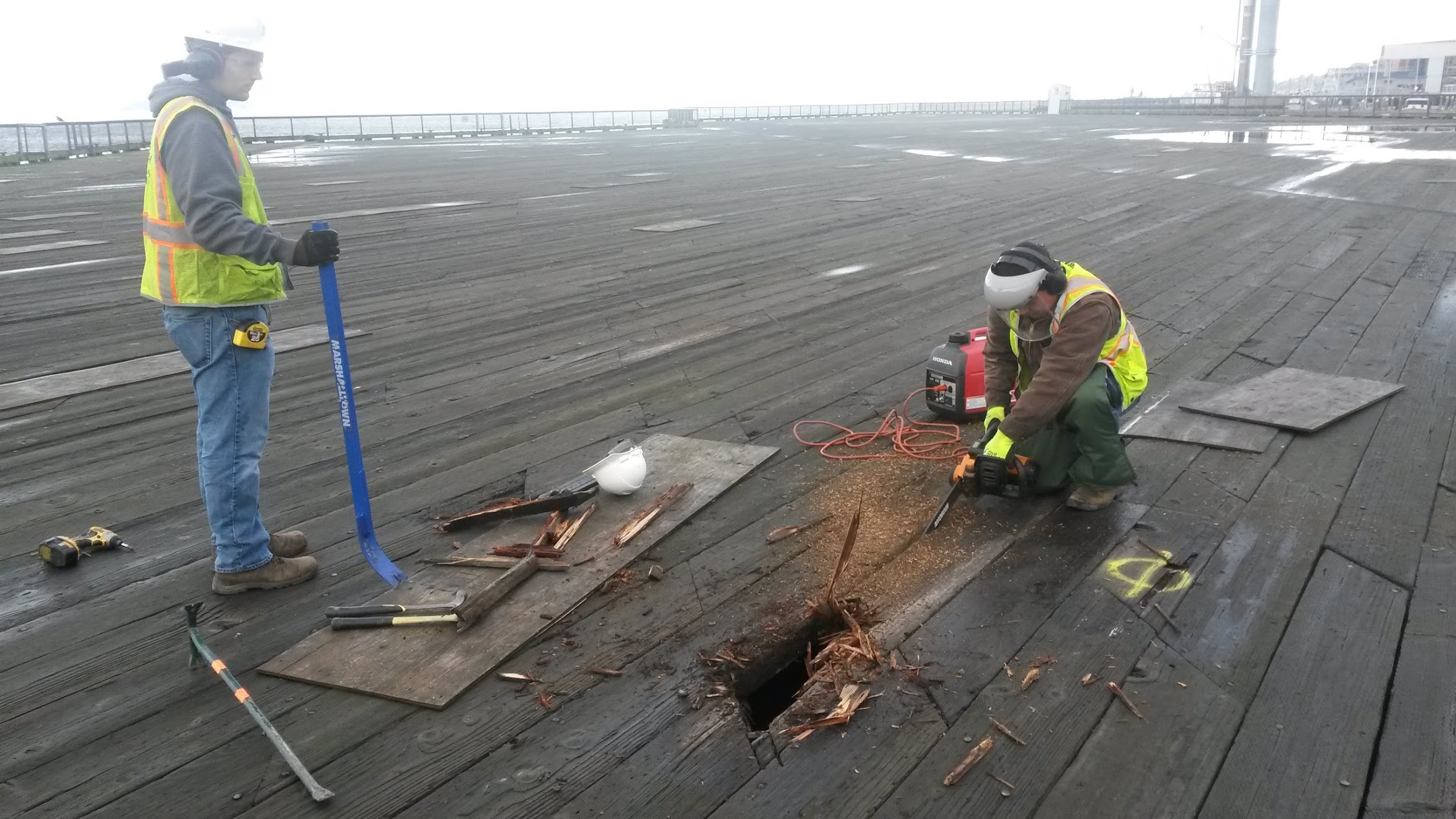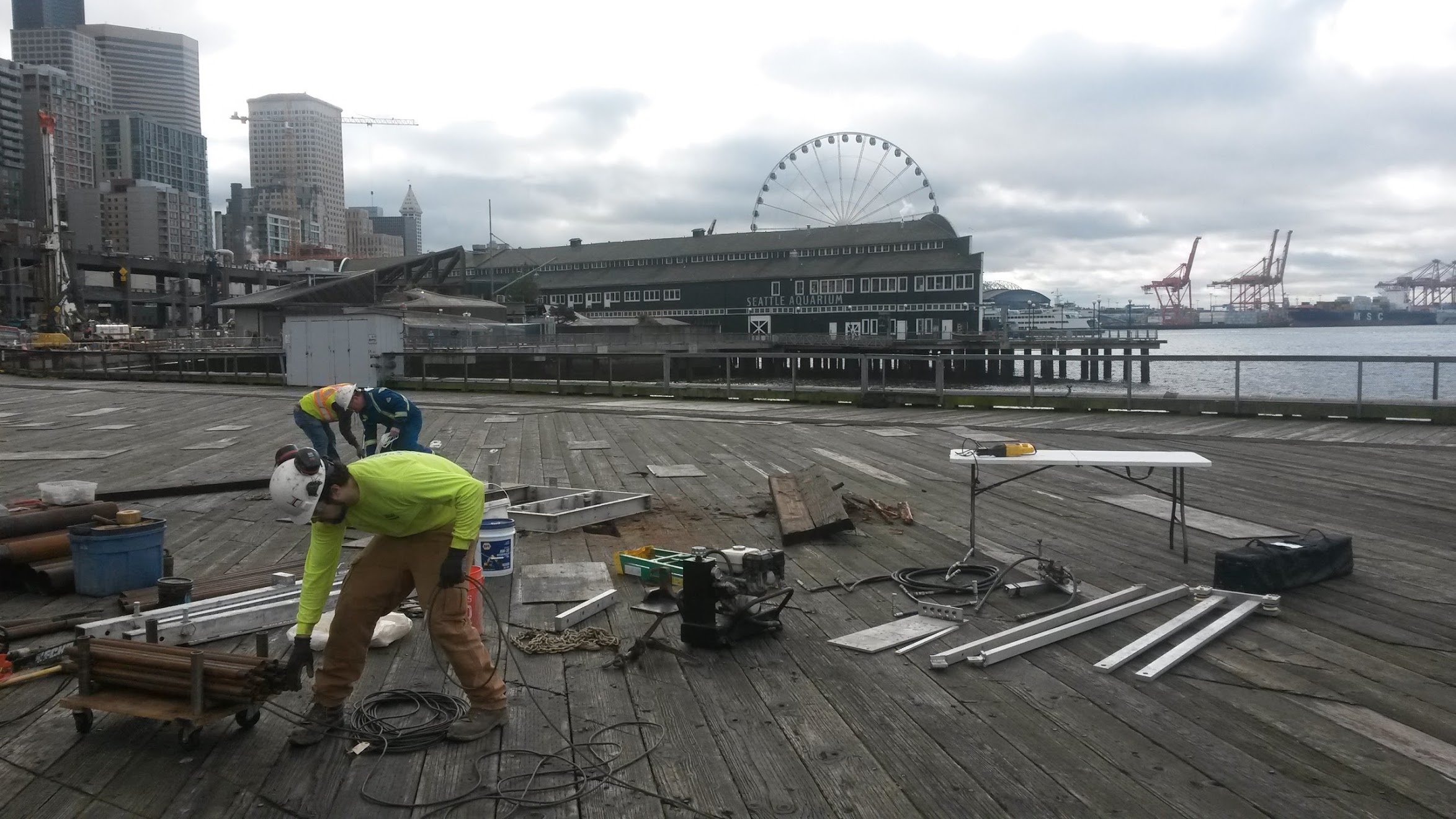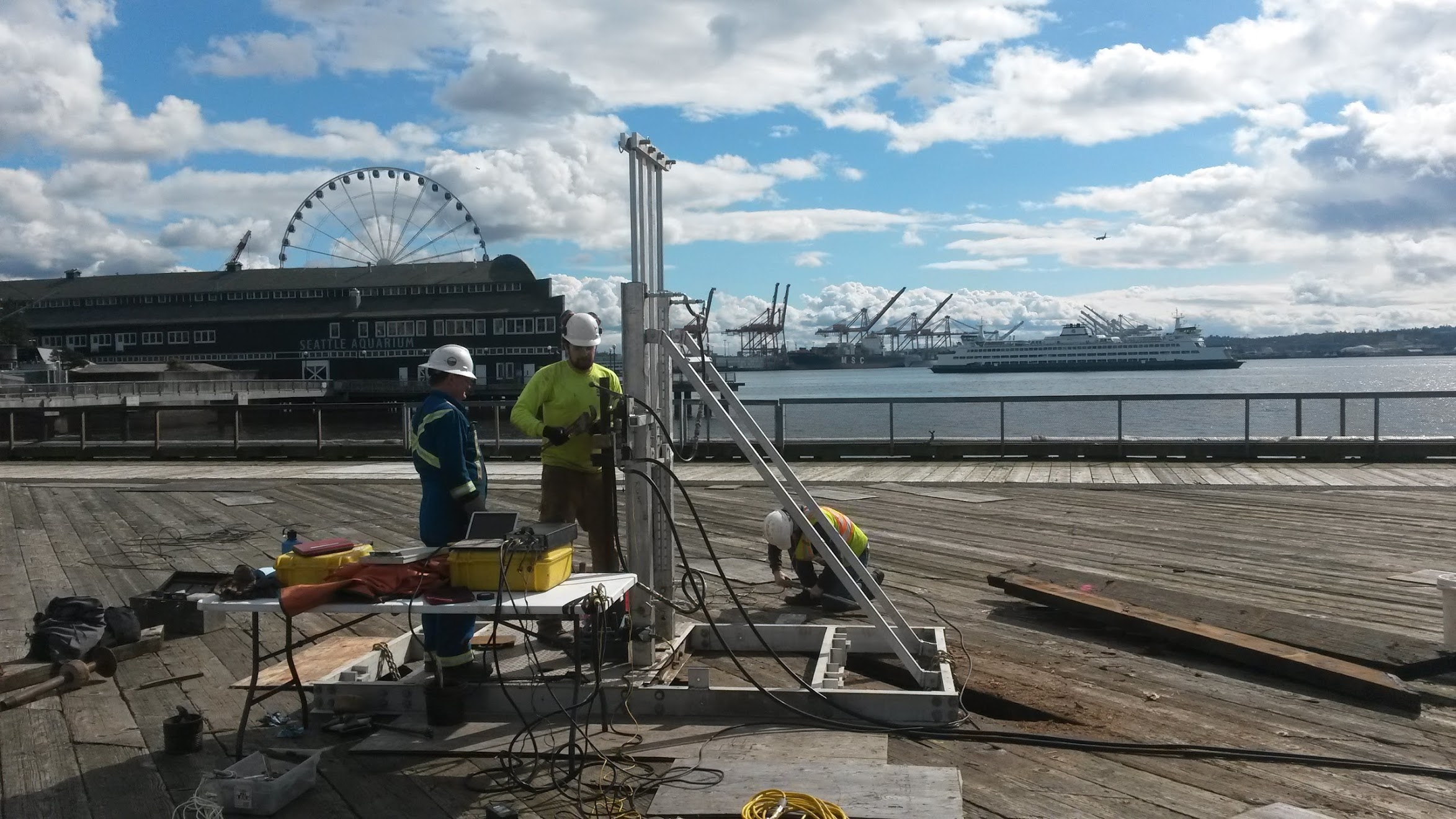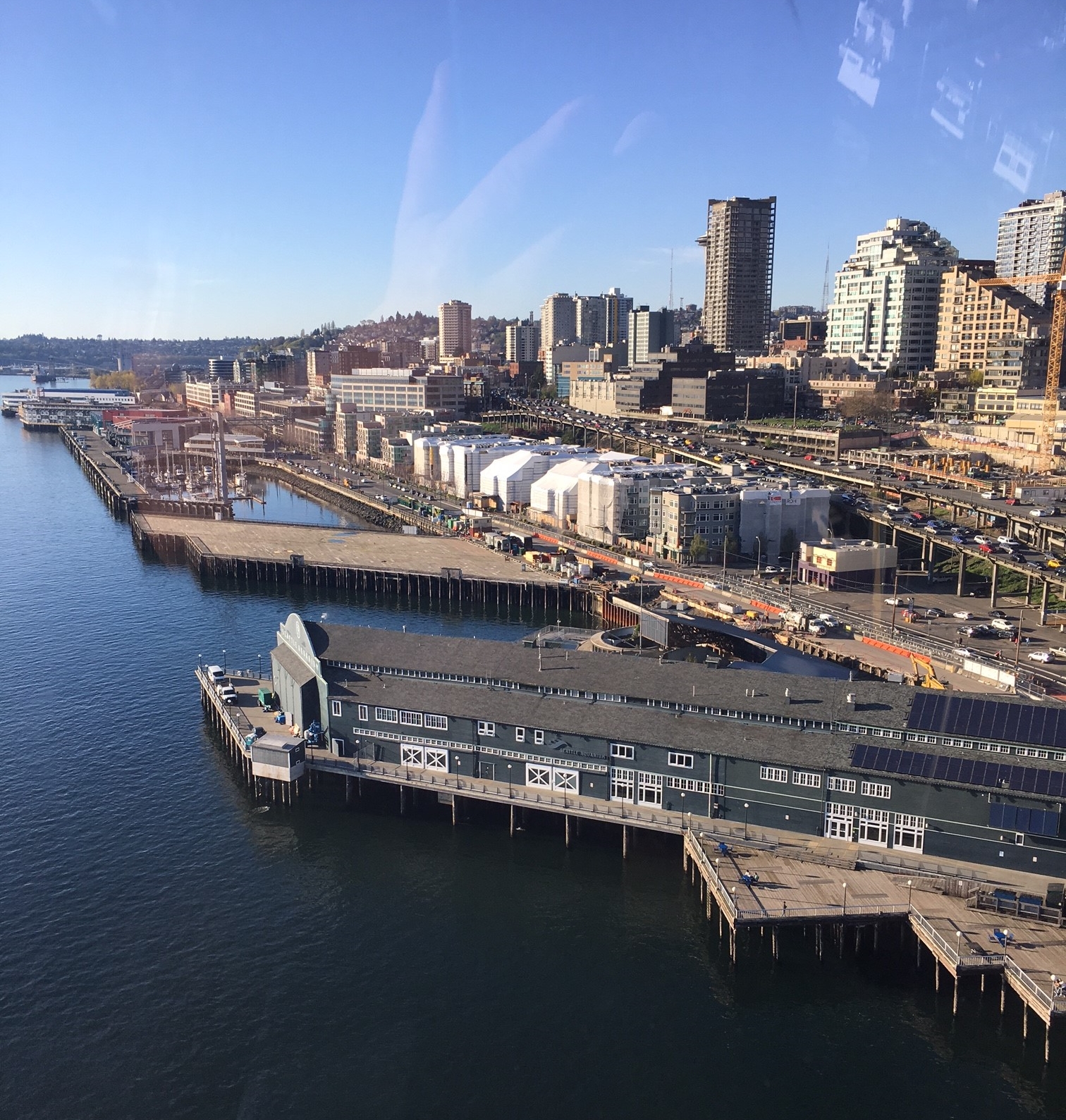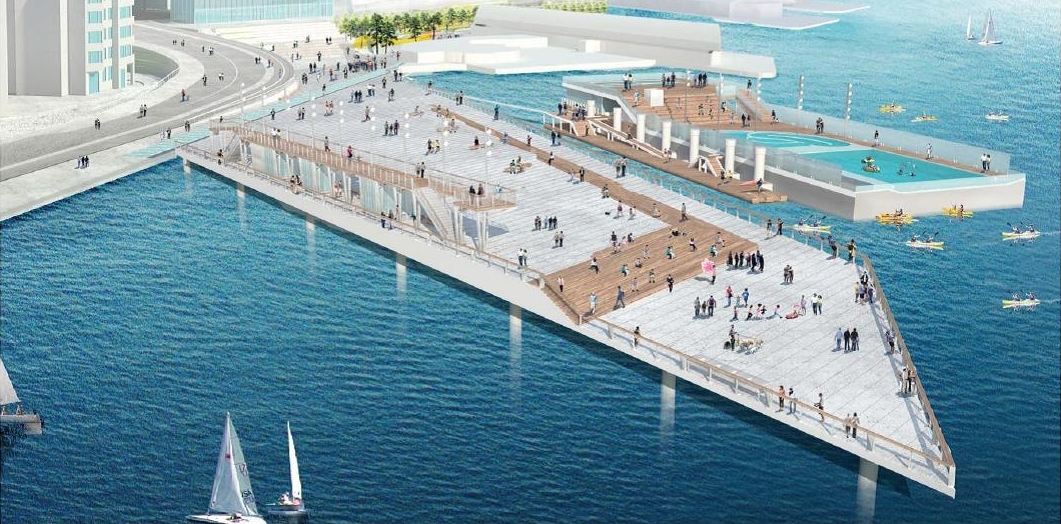Construction at Mt. Baker Housing Association’s Maddux Development is underway—the beginning of the end of a project that is bringing 203 units of affordable housing to Seattle’s Mt. Baker neighborhood. It features an innovative partnership between MBHA and Ecology as the first project under Ecology’s Healthy Housing program to help fund the environmental cleanup of future affordable housing sites. It also features a first-in-Seattle use of a ground improvement technique called displacement rigid inclusions to address the site’s challenging geology and the project’s limited budget.
Drilling the displacement rigid inclusions columns.
Soil Liquefaction Muddies Building Design
The land under the new Maddux buildings consists of very loose fill soils that lie on top of glacial recessional deposits – a hodgepodge of loose soils left behind as the last glaciers retreated from the Puget Sound area thousands of years ago. Under that are stiffer soils that were consolidated by the weight of the glacier. The loose soils are saturated by groundwater that lies on top of it unable to infiltrate into the harder soil underneath.
During an earthquake, the saturated, loosely packed grains of soils at the Maddux site could be shaken to a point where the elevated water pressure within the pore spaces increases the space between grains and causes the soil to lose strength and flow like a liquid in a process called liquefaction.
Think of wiggling your toes in the sand while standing on a beach near where the waves come in—the Maddux site soils would respond in similar fashion. When the shaking starts, the loose soils would become even weaker and any foundation bearing weight on them would settle, crack, and potentially collapse. Structures on sites like Maddux require particular design for seismic conditions in order to be built safely.
Weak Soils Get an Automatic F
The building code divides the soils at sites into six classes – ranging from A (strong rock) to F (weak, loose, liquefiable soils) – based on the characteristics of the upper 100 feet of soil from the base of any future building. These site classes set the parameters for how a building must be designed to respond to strong shaking from earthquakes.
The building code rates sites with any amount of soils at risk of liquefaction as Site Class F. Building on Site Class F sites usually requires either deep foundations or ground improvement—both of which are more expensive than conventional shallow foundations. The building itself can also be more expensive, since building on weaker soils often requires more steel and other materials. And for an affordable housing project like this one, cost is a critical factor to the viability of the project.
Conscious of these cost concerns, Aspect’s geotechnical team started to investigate the most effective foundation design for building on a Site Class F site such as Maddux. In a nutshell: It’s complicated.
Design vs. Complex Site Geology vs. Costs
This figure shows the varying elevations of bearing layer –soils that can safely bear the weight of a building foundation – at the Maddux site.
The land the Maddux site is on has been through a lot. The last glacier left not just weak soils but left them at wildly varying depths. You can drill at one spot and reach stiffer soils within a few feet of the surface, then move over 10 feet, drill again, and have the strong glacial soils be 15 or more feet further down.
Add to this the legacy contamination from former dry cleaners and a gas station that has since spread throughout the soil and groundwater. Excavation to remove contaminated soil was already part of the site’s environmental plan, but to extend that excavation to remove all the soft and liquefiable soils in addition to all the contaminated soils would have required more digging, deeper shoring, and more off-site soil disposal – and a lot more money. We also needed to make sure whatever ground improvement we used didn’t interfere with our environmental team’s remediation plan.
Whatever the method, we wanted it to be as cost-effective as possible. Ecology’s funding for the Maddux development only covers the environmental remediation. Any expense for building foundations is the responsibility of MBHA, which as a nonprofit has limited funding. Our geotechnical team carefully weighed the costs versus benefits of several options. For example, conventional deep auger cast piles, which are often used at sites like Maddux, are relatively inexpensive to install, but they require a lot of concrete and steel to construct, adding more to the cost of materials. They also don’t improve the ground around the piles; the class rating would still be an F, which increases the cost of the building itself.
Displacement Rigid Inclusions to Raise the Grade
As we weighed the factors, it became apparent that displacement rigid inclusions were the most appropriate and cost-effective technique for the site. Rigid inclusions are a ground improvement method that use columns of concrete to transfer the weight of a structure through loose soils down to more competent bearing soils below, thereby reducing potential damage from liquefaction.
What made the ground improvement for the Maddux project unique in the Seattle area was the use of displacement rigid inclusions. Displacement rigid inclusions are a type of rigid inclusion that involve specialty tooling that densifies the soil around each column. The act of drilling the columns “displaces” the ground around it. The soil between the columns is pushed together and becomes denser, thereby reducing the chance it will liquefy during an earthquake. Displacement rigid inclusions provide structural support for the building with the same element that is used to mitigate liquification.
Tests to Pass the SDCI Test
There aren’t many chances to test seismic design—the Seattle area hasn’t experienced a “design-level” earthquake, one with the magnitude we are designing our buildings for, in hundreds of years, so it can be hard to predict exactly how a building will respond. Instead, engineers study what has happened during other earthquakes under similar circumstances. We can then apply that understanding to safely develop innovative techniques to protect against earthquakes at more problematic sites like Maddux. To use displacement rigid inclusions for the Maddux project, the design required approval from the City of Seattle. Displacement rigid inclusions had never been used before to change the site class of a project in Seattle.
During design, we conducted cone penetrometer tests (CPTs) to determine the soils’ geotechnical engineering properties plus extensive laboratory tests on the soils. We worked with specialty ground improvement contractor Condon Johnson to assess whether the soils would respond to the displacement the way we thought they could. From those tests, the detailed ground improvement design was established including the spacing of each column needed to effectively strengthen the soil between columns.
Our team met regularly with Seattle Department of Construction and Inspections (SDCI) to present our design approach. Conservative estimates were developed for how much densification would be possible in the site soils. We found that the ground improvement could be designed to achieve adequate densification to eliminate liquefaction risk –and thus raise the site class.
SDCI approved the approach during design, but all was contingent on the results of verification testing after the rigid inclusions were installed. If we installed the columns and performed more CPTs that showed enough improvement in the soil strength, they would give final approval.
Installing the Columns
We started installing the displacement rigid inclusion columns at the Maddux site at the beginning of 2021. The drilling required specialty displacement auger tooling, and because this technique isn’t used much in this area, the driller had to bring the displacement auger up from California.
Displacement rigid inclusion installation in early 2021 at the Maddux site
A cage of rebar is set in place after the column is filled with concrete.
The displacement auger drilled 18-inch-diameter columns down through the weaker soils and into the underlying dense glacially overridden soil layer. As the auger pulled out, it pumped concrete into the void created by the auger pushing soil to the side. The concrete itself is under pressure, which pushed out the soil even more, which aides in densification. Once the auger was fully removed, a “cage” of rebar could then be lowered in to reinforce the concrete once it cures.
In all, there were 249 columns drilled at Maddux North and 219 at Maddux South, each placed about 5 feet apart center to center, installed over two months.
The Results
Once the displacement rigid inclusions were installed, we completed another round of CPTs to physically verify that we achieved the level of densification we predicted in design. Results from the post-treatment CPTs showed the displacement rigid inclusions had worked even better than we thought. Our team delivered the data to the City that showed the soils at Maddux were no longer liquifiable.
Aspect, as the geotechnical engineer of record, then gave the recommendation that the site class could change. This opinion was backed by the robust quality controls we used during construction, documentation of the verification CPTs, and post-treatment liquefaction analyses showing the liquefaction risk had been removed.
The Site Class at Maddux was raised from an ‘F’ to a ‘D’. A ‘D’ rating allowed for the structures to be designed using less materials, therefore saving money on construction costs.
The Maddux project represents a successful use of an innovative ground improvement technique on a complicated site in conjunction with an extensive environmental cleanup. See the Maddux ‘Story Map’ for more context on the project.









